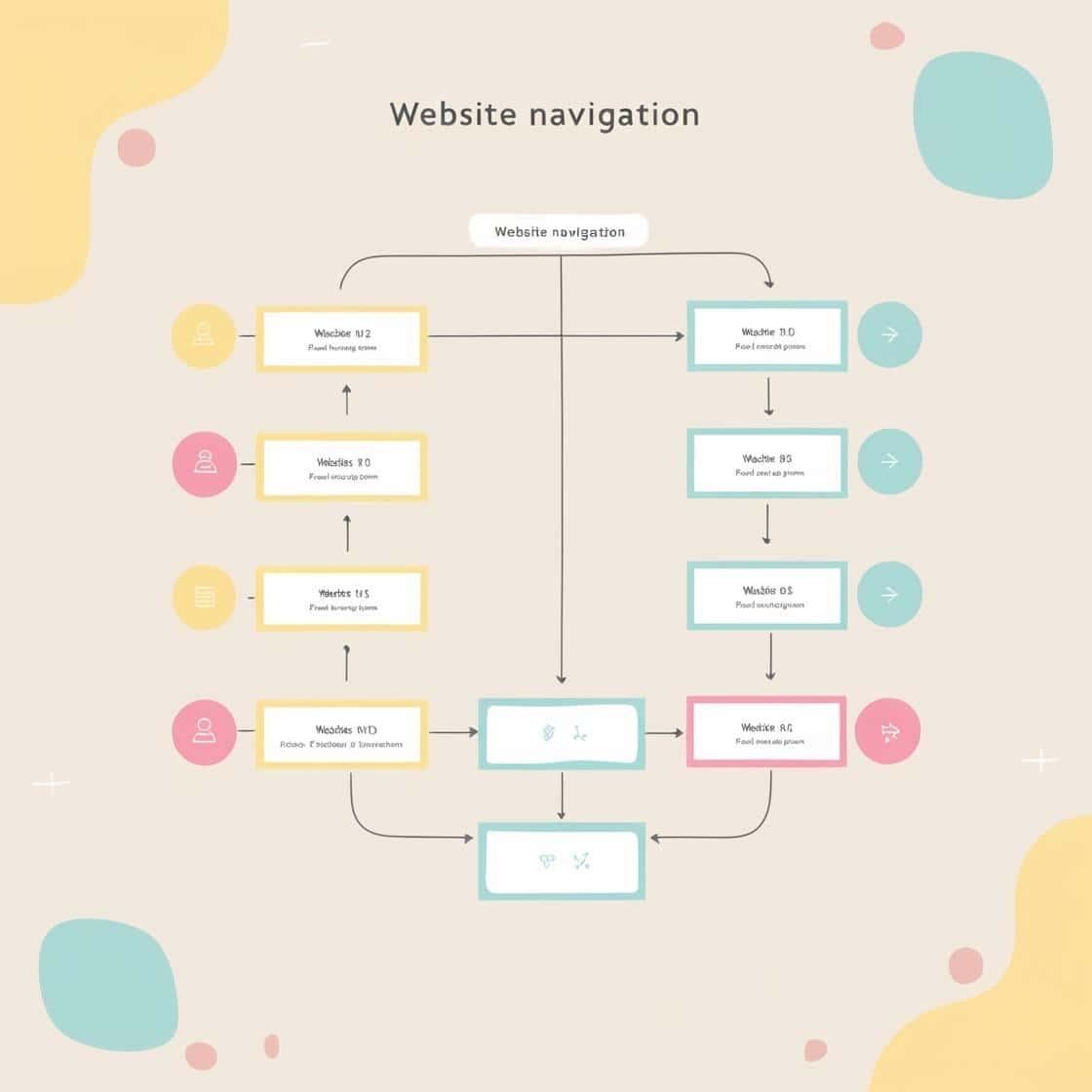Okay, let’s look into the world of web design. Let’s kick things off with website navigation. Think of it as a map for your website. Without it, visitors might feel like they’re wandering around lost. It would be like being in a huge shopping mall looking for your favourite handbag shop with no map!
So what’s navigation, exactly?
It’s the set of elements that help users move through your site, like menus, links, and buttons.
There are a few different types of navigation you might come across.
Top-level navigation ( main menu) usually sits at the top of the page, showcasing the main sections of a website, like ‘Home’, ‘About’, or ‘Contact’.

Then you’ve got sidebars. These often provide additional options or subcategories, making sure that no matter where you are on a site, you can get to where you need to go easily.
Breadcrumb trails are another navigation hero. You know those little links usually found at the top of a page showing you the path you’ve taken? Those are breadcrumbs, and they help you retrace your steps.
So why is it so vital to wrap your head around website navigation?
Because it’s all about user flow and experience.
Good navigation makes sure people stick around, explore, and find what they’re looking for without breaking a sweat. On the flip side, if your navigation’s a mess, people might just click away in frustration. Not exactly what we’re going for is it?
If you’d like to learn more about website navigation I have a lesson including a video which you can find here

For beginners, understanding navigation is like having that crucial starter Pokémon. It’s foundational. You’ll be set up for success when you know how to help users find their way around.
Remember, every website is unique, but the fundamentals of navigation give users a consistent experience no matter where they land.
The Role of Website Navigation in User Experience (UX)
In web design, navigation isn’t just about moving around a site—it’s the backbone of user experience. A well-organized navigation system shapes how visitors feel and interact on your site from the start.
First impressions matter more than you might think.
When users land on a page, they’re subconsciously assessing whether they should stick around or just leave. Effective navigation can tip the scales in your favor by making it clear, fast, and simple to explore your content.
Ease of use is where you win hearts (and clicks). If your navigation’s intuitive, anyone, even those new to surfing the web, can find what they’re looking for without a hitch. You don’t want people squinting at their screens, trying to decipher your menu logic.
Now, accessibility—I can’t stress this enough. Good navigation doesn’t just serve your average Joe. It also makes your site usable for people navigating with screen readers or other assistive technologies. This way, you’re opening your doors to everyone, which is always good.
You might wonder,
‘How do I ensure my navigation’s working well?’
Case studies can be your best friends. Check out websites known for great user experiences. Notice how they use navigation to guide users seamlessly? Take notes and adapt those strategies to your projects.
Remember, every website is unique, but the fundamentals of website navigation give users a consistent experience no matter where they land.
Getting it right can be the difference between someone staying to explore—or clicking away in confusion.
Best Practices for Creating Website Navigational Elements
Creating smooth navigation isn’t rocket science, but it definitely demands some forethought. Keep one golden rule in mind:
simple and consistent is the way to go.
When users hop from one page to the next, they should find your navigation familiar no matter where they are. It’s like passing GO in Monopoly – always reliable.
Here’s the thing about mobile responsiveness. Your site’s navigation on a desktop shouldn’t be a monster on a mobile screen. Shrink it down, maybe into a neat hamburger menu that users can tap to expand. This way, you’re always offering the best experience, whether folks are on their laptops or on the go with their phones.
SEO plays a sneaky but vital role here too. Search engines love a site that’s easy to navigate. Think of your navigation structure as a guide for search engines, helping them understand your content and rank it accordingly. It’s a win-win: users can find what they need, and your site gets the SEO love it deserves.

Before you show off your design, do some user testing. This is where you let real people, not just your team/family/friends, take your navigation for a spin. They’ll give you feedback that you might not have considered, pointing out bits that are confusing or clunky. Use this info to fine-tune your navigation before going live.
Remember, creating killer navigation isn’t about just throwing up a few links. It’s a strategic part of web design that calls for smart planning and continuous tweaking. Aim to build a map that’ll guide users smoothly from start to end, making their journey fruitful and enjoyable.
And Finally..
We’d love to hear what you think! Have you tried making your website easier to use on a phone or tablet? Maybe you’ve worked on making it load faster or look better on small screens. Even if you’re just getting started, I’d love to know—what are you finding easy or difficult? Leave a comment below and let’s learn from each other!
Here’s a little transparency: My website contains affiliate links. This means if you click and make a purchase, I may receive a small commission. Don’t worry, there’s no extra cost to you. It’s a simple way you can support my mission to bring you quality content.”


This article really got me thinking—navigation isn’t just a design element, it’s the heartbeat of a website. Without a clear map, users can easily get lost, and that often means missed opportunities. It’s fascinating how something as “simple” as intuitive menus and breadcrumb trails can transform the whole user experience. What small tweak have you made that suddenly made your site feel like home?
Hello Dan, I’m forever making ‘tweaks’ to my navigation. I’m always surfing the net to find new, simple navigation techniques. To be honest, I’m still not sure I’ve cracked it yet.
Thanks for stopping by
Jackie